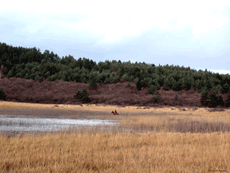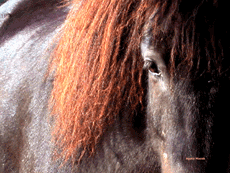Slovenia is a small European country, which borders with
 |
 | A ride in the grand nature. |  |
Austria in the north, Hungary to the east, Italy in the west and Croatia in the southeast.
The country is small indeed, but the little area it covers hides a surprising number of treasures; it takes only a few hours to go from one end to the other and at the same time to experience the beauties of the Alpine, Pannonian, Dinaric and coastal regions.
The kingdom of the Alps: mighty mountains under the protection of the highest Slovene peak - the 2,854 m-high Mount Triglav, its steep walls and blue-eyed lakes, the rare Triglav flower, capercailles, petrels, dwarf pine and mountain pastures, the Pokljuka forest. Many wild rivers have made their way through the rocks, among them the emerald Soča river.
The variety of the Pannonian plain: endless Prekmurje plains, storks on chimneys, rattles in vineyards, sources of mineral and hot water, skilful potters and cable ferries lost in dreams on the Mura river, the old Hrastovec castle overlooking Pesnica, the town of Ljutomer and its excellent trotters….
The picturesque landscape of the Dinaric region: masterpieces, shaped or chiselled by persistent water on limestone ground: sinkholes, Karst fields, intermittent lakes, disappearing Karst streams - among them the capricious Pivka river, which created the world famous Karst cave - the Postojna cave. It is the biotope of the rare proteus (Proteus anguinus). Then there are also the wild and almost impassable dense forests of the Snežnik and Kočevski rog areas.
A glimpse of the Mediterranean: the ancient town of Piran with its cliffs, the biting north-easterly, the restless sea, olive trees and vines, fishermen and saltworks, thronged villages from stone, delicious pršut dry ham from the Primorska region…
Ljubljana, the capital and main intersection of Slovenia, has a very rich history: it was inhabited ever since the end of the Ice age, on its moorlands and later in its streets and boulevards life has always been very vivid: crannogs, ancient forts, the Roman Emona, medieval capital of Carniola and always the cultural capital of Slovenia, later even its administrative and political centre. Today, Ljubljana is a modern European town with 300,000 inhabitants. And it remains the Slovene centre of culture, politics and economy. There's still the old Ljubljana castle and the old Ljubljana city centre beneath…. the river Ljubljanica running through it .. on its banks one can find the vivid pace of the city or the peace of old parks and hear the rushing of mighty willow-trees. The white Ljubljana is beautiful, indeed.
And everywhere friendly, hospitable people…
 |
 | Horses belong to Slovenia. |  |
Ever since, people in this small country showed great affection for horses. The lipizzaner breed, the white baroque beauty, originating from the Lipica stud farm in the midst of the Slovene stony Karst region is known world-wide. It is a jewel in horse breeding making everybody extremely proud, however it does not considerably affect the variety of other breeds, which can be found in Slovenia. Even Icelandic horses are among them - a total of around 300 can be found in Slovenia. The first two mares came to Slovenia ten years ago from Denmark. Some time later Slovene lovers of Icelandic horses made contacts with Austrian and German breeders so that many horses (also because of the geographical vicinity) came from these two countries. Ten years ago, the Society of Icelandic Horse Breeders of Slovenia (DRIKS) was established, which links around 100 members and is also one of the nineteen members of the FEIF. Since then a more systematic popularisation of Icelandic horses is being carried out. The main aim is to have quality riding schools and to provide such trends in local breeding, that would ensure quality riding horses. In 2003 we would like to organize the first breeder's competition, which would show the quality of our herd. It should serve as a basis for a future breeding strategy. Currently Slovenia has reached the level of ambitious amateur riders; there are practically no real competition horses and no riders as well. We are at the beginning of our way, but we still have enough of amateurship, courage and eagerness to meet the set goals. The training is performed mostly abroad in Austria, Germany or in Denmark, while foreign trainers and teachers are invited to Slovenia several times a year. There are three suitable tracks in Slovenia (all of them privately owned - they are 170, 220 and 250 m long) which are currently still meeting demand. Last summer, we prepared ourselves for the first country championships in riding Icelandic horses with the participation of 35 riders from all across Slovenia. This is a very encouraging. Everything continues to be the result of efforts by amateurs, who also provide the financial means for the "Icelandic" movement to prosper.
There is still no literature on Icelandic horses in Slovene, therefore we use foreign literature, mostly German and English translations. A good source of basic information on Icelandic horses, their history, use, care, their gaits and the society can be found on the DRIKS web page
www.islandski-konji.com, where contacts with Slovene lovers of Icelandic horses can be made. At least once a year a lecture by a renowned foreign expert regarding breeding or riding of Icelandic horses is held. We are in constant contact with the "Icelandic" trends regarding competitions, training, breeding, tourism as well as the care for horses. At this point I am particularly thinking about the latest developments regarding the curing of allergies, particularly the extremely annoying summer eczema, which a few Slovene Icelandic horses are suffering from. Our horses are very much appreciated and loved above all, therefore numerous articles are published in the only Slovene horse magazine and other publications. The response is tremendous – the interest among Slovenes for Icelandic horses is growing continuously.
Allow me to add some words on our horses. We have four Icelandic horses all bought from Helga and Bruno Podlech at the Wiesenhof estate in Germany: Sleipnir fra Skandi (eunuch) and three mares Alise von Wiesenhof, Frekja von Wiesenhof and Elding von Nedderenhof. My husband and I are fans of field riding and we could hardly find better partners for this than our four horses. They are kept in the Notranjska region, a magnificent Karst area, which due to its intermittent lakes and untamed nature is little inhabited and full of game. This is true wilderness including bears and wild boars, draughty and silent, with thousands of forest trails and Karst pastures. Such a wilderness can only be enjoyed with a self-confident horse having an excellent sense for orientation and which does not take too much notice and is not afraid of new sounds, silhouettes and scents. For this reason and for their people-friendliness, endurance, robustness and... there are a thousand features of Icelandic horses, which make them so special, and because of them they will remain members of our family forever. My horses are Frekja and Elding, Sleipnir is my husband’s horse and Alise belongs to my son.
Sleipnir fra Skardi was born in Iceland and features an extraordinary temperament - this is not a horse for everybody, because it is very strong and difficult to control. It is the best horse in flying pace in Slovenia and quite a number in tolt. It is a dun with strong, robust and stocky body. It also has an enormous desire for running around. It is a horse for the experienced and self-confident rider. A gentleman by nature, who likes to be well looked after and is by no means a plushy toy. It demands a respectful attitude. And this is what it gets. Sleipnir has 14 years.
Alise von Wiesenhof is a magnificently beautiful mare with extremely long and thick silver mane and tail, her body is dark brown-greyish. She is a strong and heavy mare and tends to less desirable flying pace. For distinctive gaits she demands quite some attention, but she can manage! In the field she is very brisk, reliable and self-confident at the same time so that I can easily entrust her with my eleven-year-old son. Her temper - you have hardly ever met such a friendly and charming horse. She is 8 years old.
Frekja von Wiesenhof is a true "little fox" with a light-gold mane. She's a villainous little thing. Even with her I have to make every effort for pure gaits (she is five-gaited), but for me this is a sort of peculiar challenge. I usually ride her out into the nature without a saddle or at least without stirrups. She is self-sufficient and does not care much about the behaviour of the herd. She is my favourite because she always likes to play jokes with me. And because whenever I call her, she comes to me running joyfully. Even from far away. She has the best GPS I know - we got lost hundreds of times but she always brought me back to the home yard without any scratch and before dusk. I have never met a more self-confident horse than this. She has 14 years.
Elding von Nedderenhof: a beautifully built, high, elegant, black beauty. My sporting mate with a lot of temperament. Four-beat - though very pure tolt, however not too fast; she is quite fast in trot and canter. And she can't get enough of running around. It's not easy to make her understand to stop according to MY judgment. But we get along. I like fast horses, which need not to be spurred. Elding can leave kilometres behind and it takes quite some time to "hold her back" not to get exhausted. Regarding speed, strength and will she is closely behind Sleipnir, however she is much easier to stop. She also has 8 years.
All four of them love to stroll around the wild countryside. They feel at home. So do we. Keeping company with Icelandic horses, these noble horses have made our lives very special. And therefore we are glad to accept the privilege of - OWNING AN ICELANDIC HORSE - in full along with all the obligations and endless pleasures provided by them.
Report by: Agata Maček
www.islandski-konji.comAnd here are some facts about Slovenia:State system: republic (independent since 1991)
Number of inhabitants: approx. 2.000,000
Surface: 20,256 km2
Total length of borders: 1,207 km
Highest mountain: Triglav (Julian Alps) - 2864 m
Highest wall: Kanjavec (Julian Alps) - 2568 m
Longest river: Sava - 221 km
Largest lake: Lake Cerknica (intermittent lake) - 24 km2
Largest nature reserve: The Triglav national park - 848 km2
Largest city: Ljubljana - 300,000 inhabitants